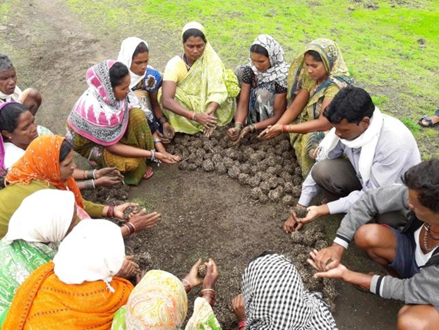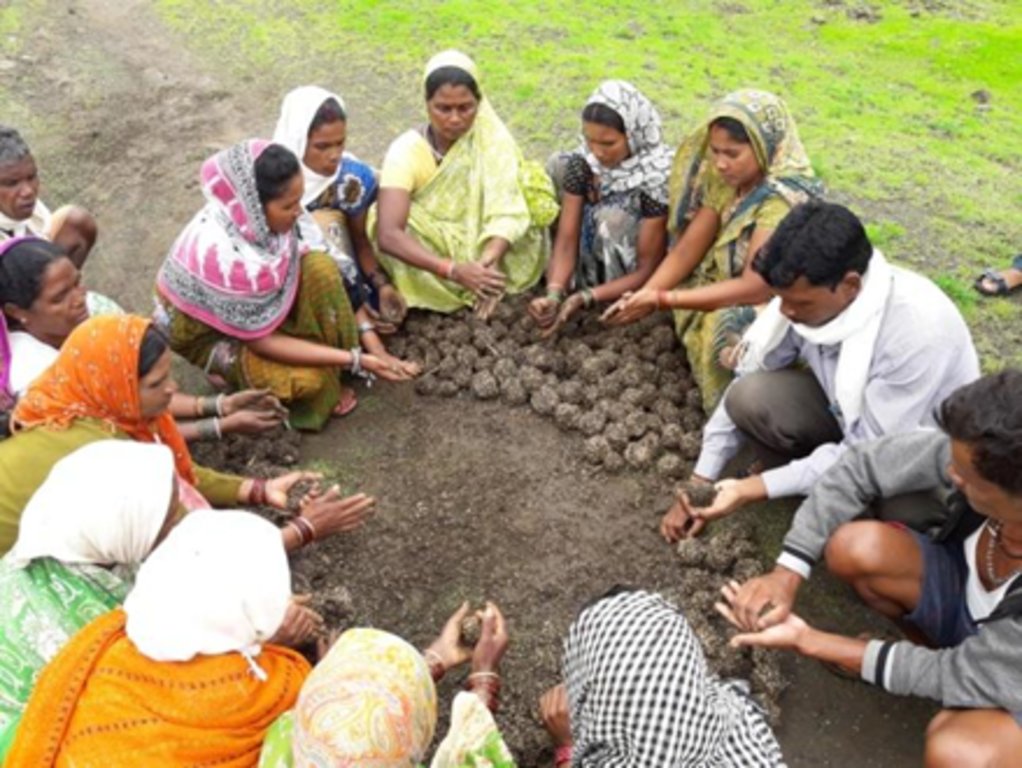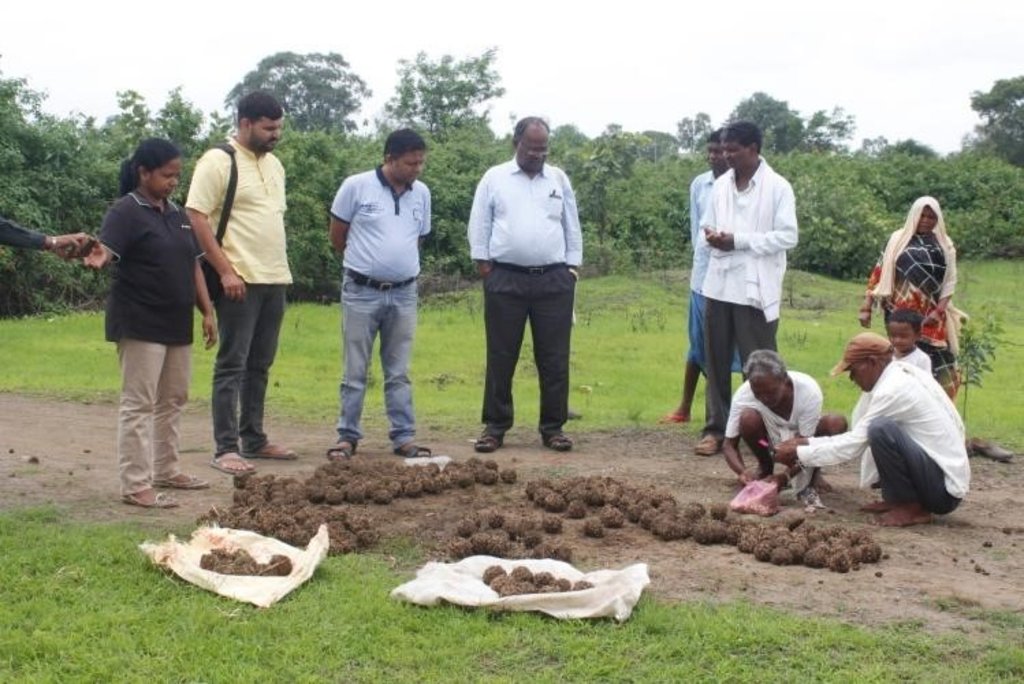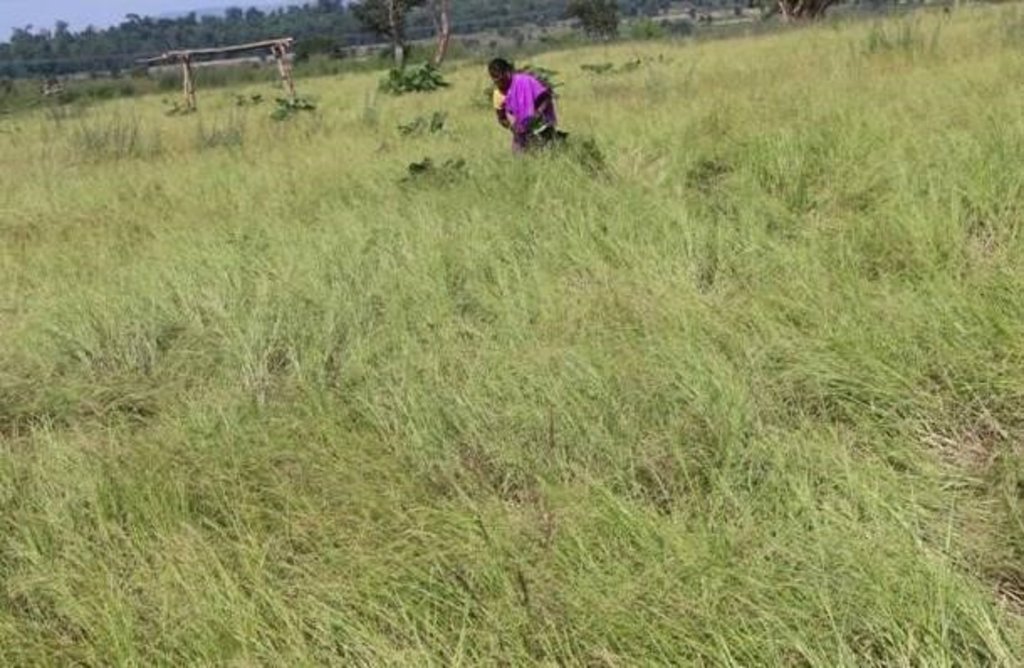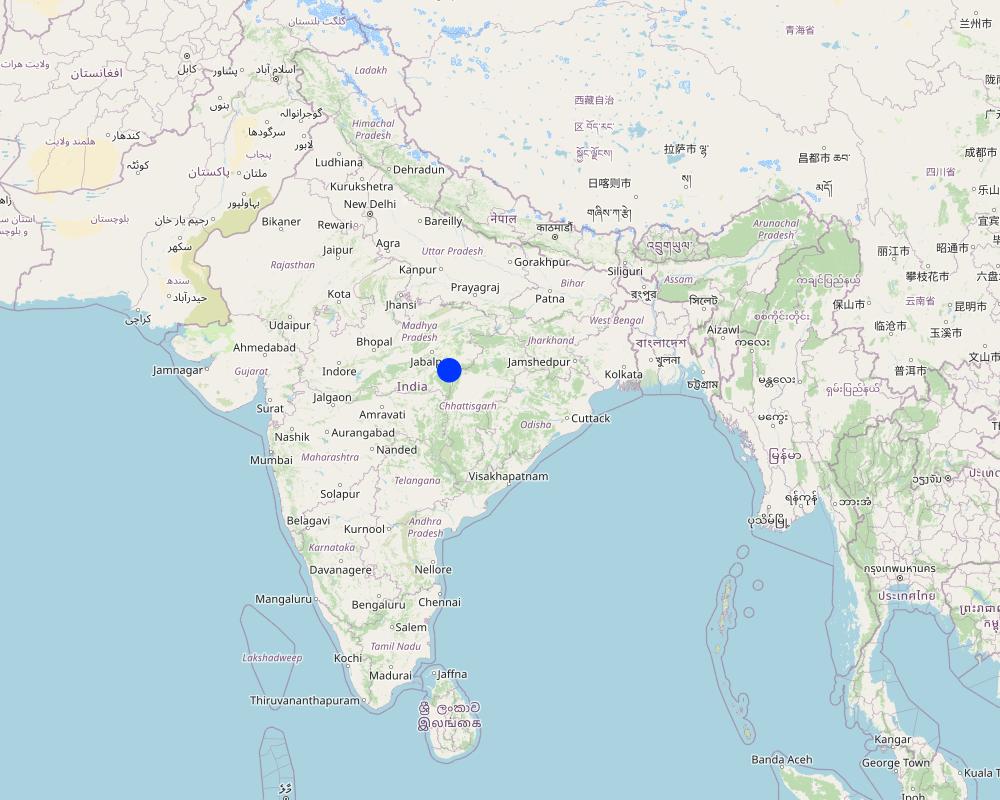Community Based Soil Rehabilitation for Grassland on Common Lands After Erdadication of the Invasive Lantana Camara [India]
- Creation:
- Update:
- Compiler: Santosh Gupta
- Editors: Noel Templer, Stephanie Katsir, Kim Arora, Tabitha Nekesa, Ahmadou Gaye, Siagbé Golli
- Reviewers: Udo Höggel, Joana Eichenberger, Sally Bunning
technologies_6689 - India
- Full summary as PDF
- Full summary as PDF for print
- Full summary in the browser
- Full summary (unformatted)
- Community Based Soil Rehabilitation for Grassland on Common Lands After Erdadication of the Invasive Lantana Camara: June 25, 2023 (inactive)
- Community Based Soil Rehabilitation for Grassland on Common Lands After Erdadication of the Invasive Lantana Camara: April 11, 2024 (inactive)
- Community Based Soil Rehabilitation for Grassland on Common Lands After Erdadication of the Invasive Lantana Camara: Sept. 14, 2023 (inactive)
- Community Based Soil Rehabilitation for Grassland on Common Lands after Eradication of the Invasive Lantana Camara: May 30, 2024 (public)
View sections
Expand all Collapse all1. General information
1.2 Contact details of resource persons and institutions involved in the assessment and documentation of the Technology
Name of project which facilitated the documentation/ evaluation of the Technology (if relevant)
Soil protection and rehabilitation for food security (ProSo(i)l)Name of the institution(s) which facilitated the documentation/ evaluation of the Technology (if relevant)
GIZ India (GIZ India) - IndiaName of the institution(s) which facilitated the documentation/ evaluation of the Technology (if relevant)
Alliance Bioversity and International Center for Tropical Agriculture (Alliance Bioversity-CIAT) - KenyaName of the institution(s) which facilitated the documentation/ evaluation of the Technology (if relevant)
Ecociate Consultants (Ecociate Consultants) - India1.3 Conditions regarding the use of data documented through WOCAT
The compiler and key resource person(s) accept the conditions regarding the use of data documented through WOCAT:
Yes
1.4 Declaration on sustainability of the described Technology
Is the Technology described here problematic with regard to land degradation, so that it cannot be declared a sustainable land management technology?
No
Comments:
The technology described is aimed at restoring community land by controlling the spread of the invasive plant species known as Lantana Camara
2. Description of the SLM Technology
2.1 Short description of the Technology
Definition of the Technology:
Community-based soil rehabilitation by eradicating the invasive plant Lantana Camara using the 'cut rootstock' method (refer to WOCAT technology 6660) is an effective, cost-efficient, and sustainable approach to restoring grasslands on common lands in the Mandla District of Madhya Pradesh. The three-tier institutional structure used in this eradication process involved the formation of informal women groups at the hamlet level (village organisational structure), the Village Environment Committee (VEC) at the village level, and an Executive Committee at the cluster level (higher organisational structure) so to ensure community involvement and ownership.
2.2 Detailed description of the Technology
Description:
Community-based soil rehabilitation after the eradication of the invasive plant species, Lantana Camara, is an effective technique for restoring grasslands on common lands that had earlier been invaded by this species. The invasion of Lantana Camara can have significant negative impacts on the ecosystem, reducing the diversity of plant life and disrupting the local communities' use of common lands for grazing, for agriculture, and for collecting non-timber forest products.
To address these issues, a three-tier institutional structure is being used by the project-implementing organization Foundation for Ecological Security (FES). This structure includes the formation of informal women groups at the hamlet level, the Village Environment Committee (VEC) at the village level, and an executive committee at the cluster level. The VEC prepares proposals on common issues and plans with budgets that are presented to the executive committee, which is made up of a mix of individuals, with 50% of the seats reserved for women.
The first step in the process is for the village executive committee to take the Gram Sabha (Village Governing Body) into confidence and prepare bylaws for the restoration and conservation of the Lantana-eradicated site. These bylaws are regularly discussed in the village institution meeting to refresh the memory of the community and different stakeholders on how to properly conserve the site. Local resource persons facilitate the implementation of work.
One of the major works undertaken by these communities in the Mandla District is the soil rehabilitation from Lantana Camara for grassland restoration on common lands. The uprooting of Lantana is a tricky process, and improper methods can result in an even more forceful recurrence of the species. Therefore, the "cut rootstock" method is used, which involves cutting the root of the plant three inches below the ground and lifting the bush upside down to prevent it from gaining ground. This method is done between July and September before fruiting to avoid seed fall, which can cause recurrence for up to three years, also this is the time when the soil has enough moisture thus softness to uproot the Lantana plants.
The Cut Rootstock (CRS) method to control the spread of Lantana Camara is cost-effective and sustainable as it does not require the use of chemical herbicides or heavy machinery. In addition to using the CRS method, perching trees are located, and saplings are removed from under their canopies and along the nearby surface runoff zone. Regular monitoring and follow-up actions may be necessary to ensure the long-term success of this method in controlling the spread of Lantana Camara.
To prevent a recurrence, measures such as mopping for three years continuously, planting and seed sowing in areas where rootstocks seem to be less, and grass seed sowing are executed. The community institution ensures the collection of indigenous grass species, which are made into seed balls and sown before the advent of monsoon. These grass seeds germinate and grow in the rainy season, reducing the suitable environment for Lantana seed germination. Revegetation measures involve selecting and planting grazing hardy, fire hardy, and water hardy tree species such as bamboo, Khameer, Java Plum, Karanj (Pongame oil tree), Aonla, Harra, and other non-timber forest product-producing tree species. These plants are selected to create a three-tiered forest and sustainably provide food, fuel wood, and fodder. Once established, they do not allow Lantana to grow.
Biomass assessment is undertaken every year to assess the improvement in the status of the biomass in the plot, and the findings are shared with the community to motivate them to follow the rules and regulations formulated by the village institution. Cut and carry practices are allowed from the second year, but open grazing is prohibited, and Lantana eradication from nearby areas is required while cutting the grass. This helps to bring Lantana under control while sustainably utilizing the grass resources.
This initiative has ensured access to common lands for the local communities, access to fodder and green grass for livestock and the emergence of biodiversity in the area. This initiative is well recognised by Government institutions and policy makers.
2.3 Photos of the Technology
2.5 Country/ region/ locations where the Technology has been applied and which are covered by this assessment
Country:
India
Region/ State/ Province:
Madhya Pradesh
Further specification of location:
Village: Changaniya, Block- Bichhiya, Mandla
Specify the spread of the Technology:
- applied at specific points/ concentrated on a small area
Is/are the technology site(s) located in a permanently protected area?
No
Comments:
The technology is applied on common lands viz. common grazing land, forest, Gram Panchayat land
Map
×2.6 Date of implementation
Indicate year of implementation:
2016
2.7 Introduction of the Technology
Specify how the Technology was introduced:
- during experiments/ research
- through projects/ external interventions
Comments (type of project, etc.):
FES has done extensive research and studies to find out the appropriate technologies and approaches to remove the Lantana plants and rehabilitate the soil by restoring grasslands
3. Classification of the SLM Technology
3.1 Main purpose(s) of the Technology
- improve production
- reduce, prevent, restore land degradation
- conserve ecosystem
- create beneficial economic impact
- create beneficial social impact
3.2 Current land use type(s) where the Technology is applied
Land use mixed within the same land unit:
Yes
Specify mixed land use (crops/ grazing/ trees):
- Silvo-pastoralism
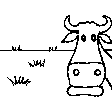
Grazing land
Extensive grazing:
- Transhumant pastoralism
Intensive grazing/ fodder production:
- Cut-and-carry/ zero grazing
- Improved pastures
- Eradication of Lantana and restoring the grasslands
Animal type:
- buffalo
- cattle - dairy
- goats
Is integrated crop-livestock management practiced?
No
Products and services:
- economic security, investment prestige
Species:
buffalo
Species:
cattle - dairy
Species:
goats

Forest/ woodlands
- (Semi-)natural forests/ woodlands
(Semi-)natural forests/ woodlands: Specify management type:
- Dead wood/ prunings removal
- Non-wood forest use
Are the trees specified above deciduous or evergreen?
- deciduous
Products and services:
- Fuelwood
- Fruits and nuts
- Grazing/ browsing
- Nature conservation/ protection
Comments:
The common land in villages which is generally not maintained, so allowing for the growth of invasive species, and unregulated open grazing is restored by the local community in a participatory manner for common benefits.
3.3 Has land use changed due to the implementation of the Technology?
Has land use changed due to the implementation of the Technology?
- Yes (Please fill out the questions below with regard to the land use before implementation of the Technology)
Land use mixed within the same land unit:
Yes
Specify mixed land use (crops/ grazing/ trees):
- Silvo-pastoralism

Grazing land
Extensive grazing:
- Transhumant pastoralism
Intensive grazing/ fodder production:
- Cut-and-carry/ zero grazing
- After restoration of common land, grasses are allowed to grow
Is integrated crop-livestock management practiced?
No

Forest/ woodlands
- Common village land and fringe areas of forests
- Indigenous grass restoration on common lands
Are the trees specified above deciduous or evergreen?
- deciduous
Products and services:
- Fuelwood
- Fruits and nuts
- Other forest products
- Grazing/ browsing
- Nature conservation/ protection
Comments:
The common lands are restored to grasslands in a participatory manner
3.4 Water supply
Water supply for the land on which the Technology is applied:
- rainfed
Comments:
Mandla is a predominantly rainfed district of Madhya Pradesh, with agriculture being the mainstay of the local economy. The District receives an average annual rainfall of around 1280 mm, with the monsoon season being the primary source of precipitation.
3.5 SLM group to which the Technology belongs
- area closure (stop use, support restoration)
- pastoralism and grazing land management
- improved ground/ vegetation cover
3.6 SLM measures comprising the Technology

vegetative measures
- V4: Replacement or removal of alien/ invasive species
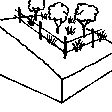
management measures
- M1: Change of land use type
- M5: Control/ change of species composition
Comments:
Invasive species are removed and the land and soil are rehabilitated by promoting the growth of indigenous grasses. During the first year, no grazing is allowed. In the second year of restoration only manual cutting/carry of grasses is permitted.
3.7 Main types of land degradation addressed by the Technology

biological degradation
- Bc: reduction of vegetation cover
- Bq: quantity/ biomass decline
- Bf: detrimental effects of fires
- Bs: quality and species composition/ diversity decline
- Bl: loss of soil life
Comments:
Lantana has several disadvantages including being unpalatable, hindering the growth of other species, reducing the collection of NTFPs (non-timber forest products), and causing soil infertility and erosion. It also provides shelter to wild boar and tigers, leading to human and cattle conflict, and catching fire. Additionally, it has a hard seed cover and can remain dormant for up to 30 years, making eradication difficult.
3.8 Prevention, reduction, or restoration of land degradation
Specify the goal of the Technology with regard to land degradation:
- reduce land degradation
- restore/ rehabilitate severely degraded land
4. Technical specifications, implementation activities, inputs, and costs
4.1 Technical drawing of the Technology
Technical specifications (related to technical drawing):
Drawing of this technology does not require as there no technical structure being build as part of the intervention. The images indicated a rehabilitated field after the eradication of Lantana.
4.2 General information regarding the calculation of inputs and costs
Specify how costs and inputs were calculated:
- per Technology area
Indicate size and area unit:
1
If using a local area unit, indicate conversion factor to one hectare (e.g. 1 ha = 2.47 acres): 1 ha =:
ha
other/ national currency (specify):
INR (2023 April)
If relevant, indicate exchange rate from USD to local currency (e.g. 1 USD = 79.9 Brazilian Real): 1 USD =:
82.12
Indicate average wage cost of hired labour per day:
204
4.3 Establishment activities
| Activity | Timing (season) | |
|---|---|---|
| 1. | Removal of lantana | September-October (After Monsoon) |
| 2. | Preparation of seeds for sowing | Before the onset of Monsoon |
| 3. | Sowing of seeds | Just before the onset of monsoon or during the monsoon (June/July) |
Comments:
The cost for Lantana eradication is being shared between the community institution and project
4.4 Costs and inputs needed for establishment
| Specify input | Unit | Quantity | Costs per Unit | Total costs per input | % of costs borne by land users | |
|---|---|---|---|---|---|---|
| Labour | Removal of lantana | ha | 1.0 | 7229.0 | 7229.0 | 20.0 |
| Labour | Land preparation for plantation | Person day | 1.0 | 200.0 | 200.0 | 100.0 |
| Labour | Sowing of seeds | Person days | 2.0 | 200.0 | 400.0 | 100.0 |
| Equipment | Land preparation for plantation | ha | 1.0 | 1000.0 | 1000.0 | 50.0 |
| Plant material | Seeds or planting material | Ha | 1.0 | 1000.0 | 1000.0 | 50.0 |
| Plant material | Cow dung and compost material | Ha | 1.0 | 2500.0 | 2500.0 | 100.0 |
| Total costs for establishment of the Technology | 12329.0 | |||||
| Total costs for establishment of the Technology in USD | 150.13 | |||||
If land user bore less than 100% of costs, indicate who covered the remaining costs:
The remaining cost is being covered by the project funds routed through community participation.
Comments:
The cost varies based on the density of lantana in the field. Depending on density, it varies from Rs 7729 per ha to Rs 2808 per ha. The work is done in a participatory manner by the local community. For the removal of the Lantana project funds routed, the plantation of indigenous grass seeds, curbing the regrowth of Lantana Camara, etc work is undertaken by the local community.
4.5 Maintenance/ recurrent activities
| Activity | Timing/ frequency | |
|---|---|---|
| 1. | Regular monitoring of the plantation area | July to November |
| 2. | Application of compost | June-July |
Comments:
Lantana Camara is a persistent weed, and even after complete eradication from common lands, its seeds can remain viable in the soil for a prolonged period. Therefore, it is essential to monitor the area regularly and prevent re-growth at the initial stage in the next few years.
Since the community works together on common lands in a participatory manner, there is very little maintenance cost involved in the process.
The density of lantana in the field can be categorized into three levels based on the number of bushes per area. A density of more than 1500 bushes per area is considered high density, while a density between 500-1500 is classified as moderately dense. A density of fewer than 500 bushes per area is known as low density.
4.6 Costs and inputs needed for maintenance/ recurrent activities (per year)
| Specify input | Unit | Quantity | Costs per Unit | Total costs per input | % of costs borne by land users | |
|---|---|---|---|---|---|---|
| Labour | Monitoring of plantation area | Person days | 12.0 | 200.0 | 2400.0 | 100.0 |
| Plant material | Application of compost | Ha | 1.0 | 2000.0 | 2000.0 | 100.0 |
| Total costs for maintenance of the Technology | 4400.0 | |||||
| Total costs for maintenance of the Technology in USD | 53.58 | |||||
If land user bore less than 100% of costs, indicate who covered the remaining costs:
The Project and other Government agencies support by providing the planting material
Comments:
This being a community-based approach a lot of activities are being done in a participatory way without the involvement of monetary transactions
4.7 Most important factors affecting the costs
Describe the most determinate factors affecting the costs:
The density of lantana in the field is categorized into 3: more than 1500 bushes are considered high density, and between 500-1500 are considered moderately dense, while less than 500 is known as lowly dense. Such categories have a decicive impact on the costs.
5. Natural and human environment
5.1 Climate
Annual rainfall
- < 250 mm
- 251-500 mm
- 501-750 mm
- 751-1,000 mm
- 1,001-1,500 mm
- 1,501-2,000 mm
- 2,001-3,000 mm
- 3,001-4,000 mm
- > 4,000 mm
Specify average annual rainfall (if known), in mm:
1427.70
Specifications/ comments on rainfall:
Monsoon season is June-September which has the majority of the rainfall
Indicate the name of the reference meteorological station considered:
District at glance report of Ministry of Water Resources, Central Groundwater Board, North Central Region BHOPAL, 2013
Agro-climatic zone
- sub-humid
- semi-arid
The National Bureau of Soil Survey & Land Use Planning (NBSS&LUP) developed twenty agroecological zones based on the growing period as an integrated criterion of adequate rainfall and soil groups. It delineated boundaries adjusted to District boundaries with a minimal number of regions. Mandla District of Madhya Pradesh lies in a hot subhumid ecoregion with red and black soil.
Precepitation - 1000–1500mm; Potential Evapotranspiration -1300–1500 mm; Lenght of Growing Period-150–180days
5.2 Topography
Slopes on average:
- flat (0-2%)
- gentle (3-5%)
- moderate (6-10%)
- rolling (11-15%)
- hilly (16-30%)
- steep (31-60%)
- very steep (>60%)
Landforms:
- plateau/plains
- ridges
- mountain slopes
- hill slopes
- footslopes
- valley floors
Altitudinal zone:
- 0-100 m a.s.l.
- 101-500 m a.s.l.
- 501-1,000 m a.s.l.
- 1,001-1,500 m a.s.l.
- 1,501-2,000 m a.s.l.
- 2,001-2,500 m a.s.l.
- 2,501-3,000 m a.s.l.
- 3,001-4,000 m a.s.l.
- > 4,000 m a.s.l.
Indicate if the Technology is specifically applied in:
- not relevant
Comments and further specifications on topography:
The project area is hilly and forested (Satpura Hill Range) and highly undulating with narrow strips of cultivated plains in the valley portion of the river. The plateau is in the northern part, formed by basalt and east-west trending hill in the southern region. The highest elevation is 934 m amsl in the northern part, and the lowest elevation is around 400 m amsl in the northwestern part of the area. Protected forest areas cover the majority of the site in the District as part of the Kanha National Park.
5.3 Soils
Soil depth on average:
- very shallow (0-20 cm)
- shallow (21-50 cm)
- moderately deep (51-80 cm)
- deep (81-120 cm)
- very deep (> 120 cm)
Soil texture (topsoil):
- coarse/ light (sandy)
- medium (loamy, silty)
Soil texture (> 20 cm below surface):
- medium (loamy, silty)
- fine/ heavy (clay)
Topsoil organic matter:
- low (<1%)
If available, attach full soil description or specify the available information, e.g. soil type, soil PH/ acidity, Cation Exchange Capacity, nitrogen, salinity etc.
Soil Testing Parameter status (Average) 2017-20 for the project areas is as follows. This data is based on the soil samples tested by the FES in its soil labs from the project villages.
Soil pH:- 5.906548628; EC (electrical conductivity):- 0.122993577; Soil Organic Carbon:- 0.83%; Nitrogen. :- 293.3696598; Phosphorus:- 25.77762582; Potassium (K):- 139.6696636; Sulphur (S):-18.93457993; Zinc (Zn):- 0.955246706; Boron (Bn):- 0.490850376
5.4 Water availability and quality
Ground water table:
5-50 m
Availability of surface water:
medium
Water quality (untreated):
poor drinking water (treatment required)
Water quality refers to:
both ground and surface water
Is water salinity a problem?
No
Is flooding of the area occurring?
No
Comments and further specifications on water quality and quantity:
The groundwater status is within the safe limits as per the reports by the Government of Madhya Pradesh. People use water from rivers, streams, and traditional small wells for domestic purposes. In the absence of good vegetative cover, the rainwater washes off the fertile topsoil from the farmlands making the land barren and resulting in the siltation of ponds and other water bodies. Further, a heavy infestation of invasive species such as Lantana Camara compounds the degradation. The studied block Bichhiya is in a better position in terms of stage of groundwater development with 17%, while the average of the district is 7%. (stage of groundwater development refers to the % of groundwater being used for various purposes from the available groundwater in that area e.g. net annual groundwater availability in Bichhiya block is 9087 ham (hectare meters) while the existing annual ground water draft for all usage is 1523 ham, making it a 17% groundwater development stage)
Source: http://cgwb.gov.in/District_Profile/MP/Mandla.pdf
5.5 Biodiversity
Species diversity:
- high
Habitat diversity:
- high
Comments and further specifications on biodiversity:
The area is surrounded by Kanha National Park and Phen Wildlife Sanctuary, with a good presence of forest area. World famous Kanha Tiger Reserve is situated in the Mandla District. Kanha is famous for Tiger and Barasingha. Kanha has numerous species of insects, butterflies, reptiles, fishes, and other lesser life forms. Important mammals, birds, reptiles, crustaceans, amphibians, insects, mollusks, and fishes are found in Kanha National Park. The faunal diversity of the district represents 32 wild animals, 63 birds, 4 fishes, and 9 reptile species, respectively. Regarding floral diversity, out of 1006 plant species available in the district, 162 are tree species, followed by 71 species of shrubs, 681 species of herbs, 51 species of climbers, 39 species of grasses, and 2 species of parasites. Mandla is richer in herbaceous species than other adjoining districts like Jabalpur and Seoni.
Source:- Documentation of Biodiversity Status in Mandla District of Madhya Pradesh.
https://mpsbb.mp.gov.in/completedProject/MB.pdf
5.6 Characteristics of land users applying the Technology
Sedentary or nomadic:
- Sedentary
Market orientation of production system:
- mixed (subsistence/ commercial)
Off-farm income:
- > 50% of all income
Relative level of wealth:
- poor
- average
Individuals or groups:
- individual/ household
- groups/ community
Level of mechanization:
- manual work
- animal traction
Gender:
- women
- men
Age of land users:
- youth
- middle-aged
Indicate other relevant characteristics of the land users:
The majority of the landusers belong to the tribal community, including some households from an ethnic community called Baiga.
https://en.wikipedia.org/wiki/Baiga_tribe
5.7 Average area of land used by land users applying the Technology
- < 0.5 ha
- 0.5-1 ha
- 1-2 ha
- 2-5 ha
- 5-15 ha
- 15-50 ha
- 50-100 ha
- 100-500 ha
- 500-1,000 ha
- 1,000-10,000 ha
- > 10,000 ha
Is this considered small-, medium- or large-scale (referring to local context)?
- small-scale
5.8 Land ownership, land use rights, and water use rights
Land ownership:
- communal/ village
- individual, titled
Land use rights:
- individual
Water use rights:
- communal (organized)
Are land use rights based on a traditional legal system?
Yes
Specify:
The concerned authorities have issued landowners the land certificates.
Comments:
Communities have the legal rights for land ownership and other resources. The mentioned intervention is being undertaken on the commons, having legal rights of local self-governance institutions like Gram Panchayat or Joint Forest Management Committees.
5.9 Access to services and infrastructure
health:
- poor
- moderate
- good
education:
- poor
- moderate
- good
technical assistance:
- poor
- moderate
- good
employment (e.g. off-farm):
- poor
- moderate
- good
markets:
- poor
- moderate
- good
energy:
- poor
- moderate
- good
roads and transport:
- poor
- moderate
- good
drinking water and sanitation:
- poor
- moderate
- good
financial services:
- poor
- moderate
- good
Comments:
Parts of the District suffer from poor road and transportation network
6. Impacts and concluding statements
6.1 On-site impacts the Technology has shown
Socio-economic impacts
Production
fodder production
Comments/ specify:
From the second year onwards after the restoration of the grassland, the grass can be made available for cattle through a cut and feed method. This involves cutting the grass in a controlled manner and providing it to the cattle as feed. By using this method, the grass can be harvested at its optimum stage of growth, and the cattle can be provided with high-quality feed throughout the year. Additionally, this method allows for better utilization of the grass, minimizing any waste or overgrazing of the grassland.
animal production
Comments/ specify:
Availability of fodder to villages from common lands
land management
Comments/ specify:
Lantana Camara is a problematic weed that has many disadvantages. It can reduce biodiversity, decrease soil fertility, and impede the growth of other plant species. Moreover, it can also be toxic to livestock and humans if ingested.
The restoration of grasslands and the eradication of lantana can help in land management. By removing the weed, the growth of other plant species can be promoted, leading to increased biodiversity and improved soil fertility. The removal of lantana can also help to reduce the risk of wildfires, as it is known to be a highly flammable plant.
Other socio-economic impacts
Restoration of grassland and regulating the use of indigenous grasses as fodder for cattle
Comments/ specify:
The restoration of grassland and regulation of indigenous grasses for cattle fodder can benefit villagers both socially and economically. Socially, it promotes community involvement and ownership of the land, while promoting sustainable land use practices benefit the environment and community. Economically, the restoration provides a sustainable source of income through the sale of milk and meat products, and eco-tourism can help to boost the local economy.
Ecological impacts
Soil
soil cover
Comments/ specify:
Lantana is known to release allelopathic compounds into the soil, which can inhibit the growth of other plant species. By removing Lantana, the negative impact of these compounds on the soil are reduced, which can promote the growth of a wider range of plants.
Biodiversity: vegetation, animals
Vegetation cover
Comments/ specify:
Diversified vegetation cover supports land restoration
plant diversity
invasive alien species
animal diversity
Climate and disaster risk reduction
fire risk
Comments/ specify:
Eradicating Lantana Camara reduces the risk of wildfires as it is highly flammable and provides a significant fuel source. Removing Lantana reduces the fuel source for fires, especially in areas prone to wildfires or near human settlements. Moreover, removing Lantana can promote the growth of more fire-resistant plant species, creating a more resilient ecosystem that can better withstand natural disasters.
Specify assessment of on-site impacts (measurements):
All of the impact areas indicated in the document are based on the discussions with community members, community institutions and project implementing teams. However, a detailed scientific assessment has not taken place so far.
6.2 Off-site impacts the Technology has shown
damage on neighbours' fields
Comments/ specify:
The spread of Lantana Camara seeds was reduced within neighboring fields
6.3 Exposure and sensitivity of the Technology to gradual climate change and climate-related extremes/ disasters (as perceived by land users)
Climate-related extremes (disasters)
Climatological disasters
| How does the Technology cope with it? | |
|---|---|
| forest fire | very well |
| land fire | very well |
Comments:
All of the impact areas indicated in the document are based on the discussions with community members, community institutions and project implementing teams. However, a detailed scientific assessment has not taken place so far.
6.4 Cost-benefit analysis
How do the benefits compare with the establishment costs (from land users’ perspective)?
Short-term returns:
positive
Long-term returns:
very positive
How do the benefits compare with the maintenance/ recurrent costs (from land users' perspective)?
Short-term returns:
very positive
Long-term returns:
very positive
Comments:
Overall, this is a very cost effective technology without having any negative impact on the human and the natural environment
6.5 Adoption of the Technology
- 1-10%
If available, quantify (no. of households and/ or area covered):
On more than 100 locations common land locations this work has been undertaken
Of all those who have adopted the Technology, how many did so spontaneously, i.e. without receiving any material incentives/ payments?
- 0-10%
Comments:
This being a relatively new intervention, spontaneous adoption will take some time
6.6 Adaptation
Has the Technology been modified recently to adapt to changing conditions?
No
6.7 Strengths/ advantages/ opportunities of the Technology
| Strengths/ advantages/ opportunities in the land user’s view |
|---|
| Eradication of Lantana Camara reduces its spread and provided access into the forest areas |
| The common lands are restored to grasslands |
| Fodder available for cattle |
| Strengths/ advantages/ opportunities in the compiler’s or other key resource person’s view |
|---|
| Rehabilitation of the soil by eradication of Lantana Camara |
| Sustainable use of common resources for the purpose of biodiversity restoration |
| A participatory approach for resolving common issues |
6.8 Weaknesses/ disadvantages/ risks of the Technology and ways of overcoming them
| Weaknesses/ disadvantages/ risks in the land user’s view | How can they be overcome? |
|---|---|
| Continuous monitoring of the regrowth of Lantana Camara as the seeds stay dormant in the soil for many years | Monitoring, and promoting growth with indigenous grasses, local trees, etc. so that the land is not kept fallow |
| Conflict among the members of community institutions for the management of the common property resources | Handholding and training of community institutions |
| Weaknesses/ disadvantages/ risks in the compiler’s or other key resource person’s view | How can they be overcome? |
|---|---|
| Currently, the program funds the eradication of Lantana Camara undertaken by the local community | Including the work under Mahatma Gandhi National Rural Employment Guarantee Act 2005 or MGNREGA |
| Mechanism to scale up the program participatory approach to manage common land resources | Integrating it with other government schemes |
7. References and links
7.1 Methods/ sources of information
- field visits, field surveys
10
- interviews with land users
5
- compilation from reports and other existing documentation
2
When were the data compiled (in the field)?
22/02/2023
Comments:
During the field visit along with visiting the sites, discussions were held with community institutions, community members, the project implementing agency and other concerned stakeholders to understand the processes, impacts, challenges and future plans
7.2 References to available publications
Title, author, year, ISBN:
Ecological Restoration of Lantana-Invaded Landscapes in Corbett Tiger Reserve, India Suresh Babuy Amit Love and Cherukuri Raghavendra Babu
Available from where? Costs?
https://www.jstor.org/stable/43441335
Title, author, year, ISBN:
Impacts of biochar application on upland agriculture: A review Kumuduni Niroshika Palansooriyaa,1, Yong Sik Oka,1, Yasser Mahmoud Awada, Sang Soo Leeb, Jwa-Kyung Sungc, Agamemnon Koutsospyrosd, Deok Hyun Moone,∗
Available from where? Costs?
https://pubmed.ncbi.nlm.nih.gov/30616189/
7.3 Links to relevant online information
Title/ description:
Lantana Demo Video
URL:
https://www.youtube.com/watch?v=1d80KyKPkDo
Links and modules
Expand all Collapse allLinks
No links
Modules
No modules


